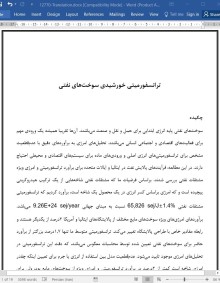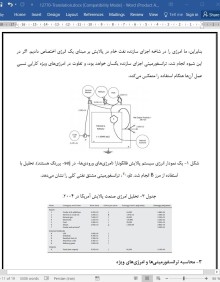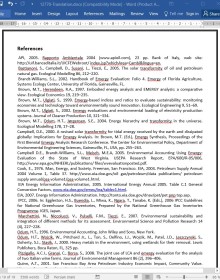
دانلود مقاله ترانسفورمیتی خورشیدی سوخت های نفتی
1- مقدمه
امرژی خورشیدی (از الان امرژی) یک مفهوم توسعه یافته توسط H.T. Odum در اوایل دهه 1980 برای درنظر گرفتن نیازمندی انرژی اساسی در به دست آوردن یک محصول می باشد. این به صورت انرژی خورشیدی موجود به طور مستقیم یا غیرمستقیم استفاده شده برای ایجاد یک سرویس یا محصول تعریف شده است (Odum 1996). دلیل اینکه چرا این انرژی یک نوع خاص است (خورشیدی) توانایی متفاوت آن در انجام کار فیزیکی واقعی از یک ژول از انواع متفاوت انرژی می باشد. بنابراین انرژی خورشیدی واحد بنیادی است چونکه اساس تمام انواع دیگر انرژی در زیست کره می باشد.
امرژی تمام انرژی در فضا و زمان پرداخته شده به یک محصول را بیان می کند. این کمیت و کمیت افزایشی، ترانسفورمیتی (تعریف شده به صورت انرژی خورشیدی مورد نیاز، مستقیم یا غیرمستقیم، برای به دست آوردن یک ژول از محصول) اساس ارزیابی امرژی می باشند. ترانسفورمیتی مسیر تبدیلات امرژی در جهان را با یک طراحی سلسله مراتب امرژی منعکس می کند. ترانسفورمیتی ها موقعیت هر شکل از انرژی جهان را در این سلسله-مراتب انرژی جهانی نشان می دهند (براون و همکاران، 2004).
چونکه تعریفات امرژی و ترانسفورمیتی بیشتر براساس یک منطق حفظ کردن تا حفاظت کردن است، یک جبر امرژی ارائه شده است. مخصوصا، تفاوت بین دسته های شاخه ها و محصولات جانبی (محصولات فرعی) می تواند به صورت زیر بیان شود (براون و هرندین، 1997):
• محصولات فرعی از یک فرآیند امرژی کل اختصاص داده شده به هر مسیر را دارند؛
• هنگامیکه یک مسیر شکافته می شود، امرژی به هر پایه شاخه براساس درصد جریان انرژی کل آن در مسیر اختصاص داده می شود.
تعیین امرژی مربوط به سوخت های نفتی یک فاکتور مهم در تقریبا هر ارزیابی امرژی است که سیستم های غالب انسانی را در نظر می گیرد. استفاده مستقیم از سوخت های نفتی ممکن است وابسته به نوع سیستم بررسی شده دارای بزرگی متغیری باشد، ولی استفاده های غیرمستقیم آن تقریبا از هر جنبه تمدن مبتنی بر صنعت ما پشتیبانی می کنند. در 1995، استفاده از سوخت های فسیلی و مواد معدنی برای حدود 3/2 از اساس امرژی برای زمین درنظر گرفته شد (براون و اولگیاتی، 1999). اما، در یک ارزیابی امرژی ایالت ویرجینیای غربی کمپبل و همکاران (2005) نشان دادند که نفت مستقیما استفاده شده 5.3درصد از امرژی کل استفاده شده و 7.3درصد از امرژی وارد شده را نشان می دهد. در سیستم های تولید کشاورزی، سوخت نفتی یک ورودی مستقیم مهم است، که بین 10 و 19درصد از ورودی های امرژی مستقیم برای شراب (پیزیگالو و همکاران، 2008)، 6.7درصد برای دانه ذرت، 7.5درصد برای شیر، و 15.6درصد برای لوبیای سبز (براندت-ویلیامز، 2002) درنظر گرفته شد. به طور کلی، ارزیابی های امرژی به کمیت ها و ترانسفورمیتی های سوخت های استفاده شده برای پشتیبانی از سیستم-ها و انجام فرآیندها حساس می باشند، یعنی، نوع سوخت یک متغیر بنیادی در محاسبه ترانسفورمیتی برق می-باشد (اودوم، 1996). به این دلیل، مهم است که این مقادیر تاحدامکان دقیق محاسبه شوند.
1. Introduction
Solar Emergy (from now on simply emergy) is a concept developed by H.T. Odum in the early 1980s to account for the basic energy requirements in obtaining a product. It has been defined as “the available solar energy used up directly and indirectly to make a service or product” (Odum, 1996). The reason why the energy has to be of one particular type (solar) is the totally different ability in performing actual physical work from a joule of different types of energy. Solar energy is then the fundamental unit since it is the basis of all other types of energy in the biosphere.
Emergy expresses all the energy in space and time going into a product. This quantity and the “intensive” quantity, transformity (defined as the solar energy required, in direct and indirect ways, to obtain a joule of product) are the basis of emergy evaluation. Transformity reflects the pathway of energy transformations in the universe, designing an energy hierarchy. Transformities indicate position of each form of energy of the universe in this universal energy hierarchy (Brown et al., 2004).
Since the definitions of emergy and transformity are based more on a logic of “memorization”, than of conservation, an algebra of emergy has been introduced. In particular the difference between the categories of splits and co-products (or by-products) can be expressed as (Brown and Herendeen, 1997):
• By-products from a process have the total emergy assigned to each pathway;
• When a pathway splits, the emergy is assigned to each ‘leg’ of the split based on its percentage of the total energy flow on the pathway.
Determining the emergy contributed by petroleum fuels is an important factor in almost every emergy evaluation that considers human-dominated systems. The direct use of petroleum fuels may be of variable magnitude, depending on the type of system examined, but its indirect uses support almost every aspect of our industrial-based civilization. In 1995, the use of fossil fuels and minerals accounted for about 2/3 of the emergy basis for the earth (Brown and Ulgiati, 1999). However, in an emergy evaluation of the State of West Virginia Campbell et al. (2005) showed that the petroleum used directly represents 5.3% of the total emergy used and 7.3% of the imported emergy. In agricultural production systems petroleum fuel is an important direct input, accounting for between 10% and 19% of direct emergy inputs for wine (Pizzigallo et al., 2008), 6.7% for grain corn, 7.5% for milk, and 15.6% for green beans (Brandt-Williams, 2002). Petroleum can be especially important in industrial systems where fuel accounted for 71% of the emergy required for the production of caustic soda, 48% for diatomite, and 26% for 20% sulphuric acid (Odum et al., 2000). In general, emergy evaluations are sensitive to the quantities and transformities of fuels used to support systems and carry out processes, e.g., fuel type is a fundamental variable in the calculation of the transformity of electricity (Odum, 1996; Brown and Ulgiati, 2002). For this reason, it is important that these values be calculated as precisely as possible.
چکیده
1- مقدمه
1-1 شاخه یا محصول فرعی؟
2- مواد و روش ها
2-1 خصوصیات اصلی یک پالایشگاه
2-2 نیروگاه فالکونارا
2-3 سیستم پالایش نفت در ایالات متحده آمریکا
3- نتایج و بحث
3-1 حل معمای شاخه/محصول جانبی
3-2 شاخه در جرم یا در انرژی؟
3- محاسبه ترانسفورمیتی ها و امرژی های ویژه
3-4 ارزیابی عدم قطعیت مدل های انرژی برحسب شاخه جرمی با استفاده از داده های 2004 از صنعت پالایش آمریکا
4- نتیجه گیری
منابع
Abstract
1. Introduction
1.1. Split or co-product?
2. Materials and methods
2.1. Main characteristics of a refinery
2.2. The Falconara plant
2.3. The oil refinery system in the United States of America
3. Results and discussion
3.1. Solution of split/co-product dilemma
3.2. Split in mass or in energy?
3.3. Calculation of transformities and specific emergies
3.4. Evaluation of the uncertainty of the energy versus mass split models using 2004 data from the U.S. refining industry
4. Conclusions
references
- اصل مقاله انگلیسی با فرمت ورد (word) با قابلیت ویرایش
- ترجمه فارسی مقاله با فرمت ورد (word) با قابلیت ویرایش، بدون آرم سایت ای ترجمه
- ترجمه فارسی مقاله با فرمت pdf، بدون آرم سایت ای ترجمه



